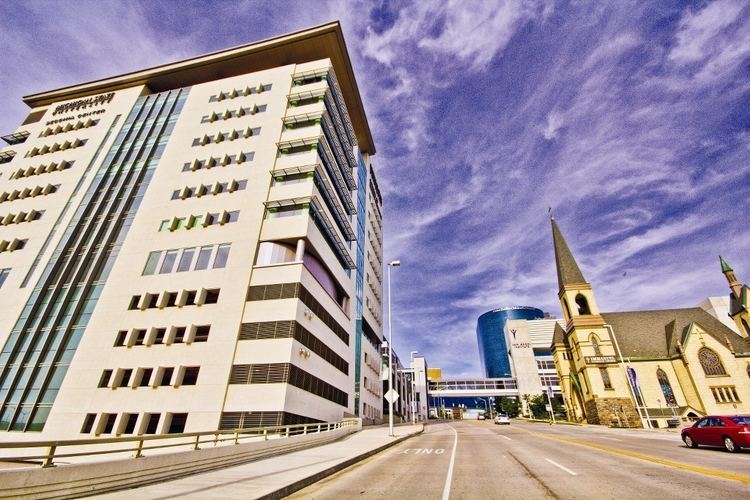 | ||
Similar Butterworth Hospital, Belknap Park, Beckering Family Carillon T, Cook Carillon Tower, Heritage Hill Historic District | ||
Collaborative case study the grand rapids medical mile
Grand Rapids Medical Mile is a designated area within the city of Grand Rapids, Michigan. It began with medical-related development in the Hillside District Grand Rapids, Michigan, bordering both sides of Michigan Street. More than a decade later it encompasses an area five times larger. It has also been referred to as Grand Rapids Medical Corridor, Michigan Street Medical Corridor, Health Hill, Medical Hill, and Pill Hill, among other names. It was started in 1996 with the founding of Van Andel Institute by Jay and Betty Van Andel. It has since expanded to include the Grand Rapids Community College's Calkins Science Center across Bostwick Avenue, Spectrum Health's Butterworth Hospital complex, Grand Valley State University's Cook-DeVos Center for Health Sciences, and Michigan State University Secchia Center Medical School, among other facilities in the area.
Contents
- Collaborative case study the grand rapids medical mile
- Van Andel Institute
- Michigan State University College of Human Medicine Secchia Center
- Spectrum Health System
- Butterworth Hospital
- Meijer Heart Center
- Helen DeVos Childrens Hospital
- Lemmen Holton Cancer Pavilion
- GVSU Cook DeVos Center for Health Sciences
- Medical Mile Resource Group
- RDVChristman Michigan Street Development
- Mid Towne Village
- Calkins Science Center
- References

Van Andel Institute
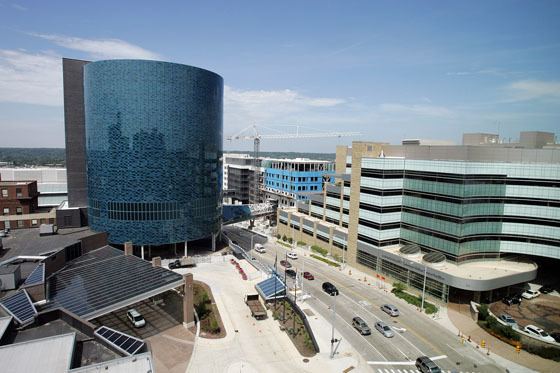
Van Andel Institute (VAI) is a research institution that primarily conducts cancer research, but also studies other diseases such as osteoporosis, heart disease, diabetes and Parkinson's disease. It was founded in 1996 by philanthropists Jay and Betty Van Andel. At the time "there was little scientific activity in Grand Rapids." The institute opened in 2000 and expanded in 2009. Initially, most of the research was funded by an endowment from Jay Van Andel, which has been estimated at $1 billion. Jay Van Andel suffered from Parkinson's disease; Betty suffered from Alzheimer's disease. Their son, Dave, is the current CEO.
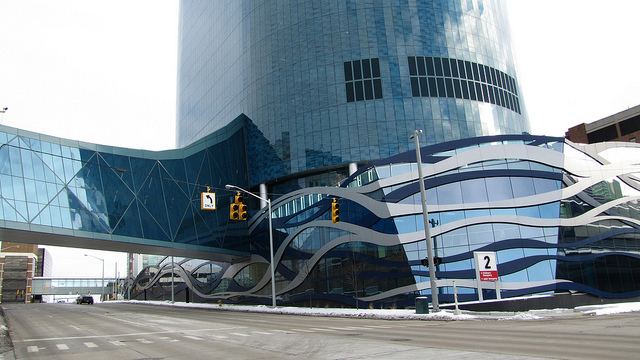
The VAI facility was built in two phases. The $60 million first phase was 160,000 square feet (15,000 m2) and included 40,000 square feet (3,700 m2) of laboratory space. It also featured the 325-seat Tomatis Auditorium and the Cook-Hauenstein Hall. It is located on Bostwick Avenue with the north end on Michigan Street.
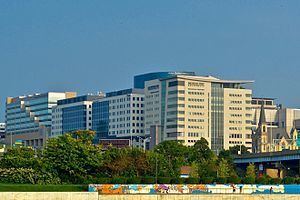
On May 17, 2005, VAI announced plans to expand. The expansion was approved by the City of Grand Rapids in October 2006, and construction for the expansion began on April 12, 2007. The cost of the expansion was $178 million, raised through donations and a bond. The second phase added an additional 242,000 square feet (22,500 m2), including 95,000 square feet (8,800 m2) of lab space. The new facility houses the Van Andel Education Institute's PhD-granting graduate school, which was founded in 2007. Michigan State University medical students also have research space in the facility. The building was designed by "world-renowned architect" Rafael Viñoly and will be LEED-certified. The second phase added a 100-seat cafeteria and 90-seat conference center.

The institute has 270 employees. Over the next several years, it is expected to grow to about 800 employees, most of them research scientists. VAI operates on an annual budget of $40 million, much of which comes from research grants and donations. Numerous local schools have donated money to fund medical research. The VAI endowment allows all donations to go directly to research.
Michigan State University College of Human Medicine Secchia Center
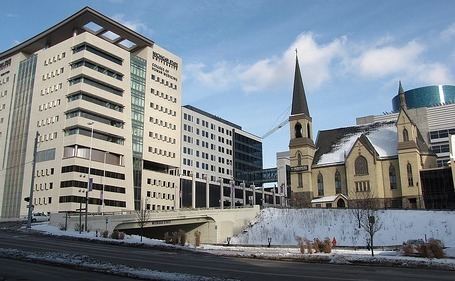
The MSU College of Human Medicine Secchia Center houses the Grand Rapids portion of the MSU's M.D. medical school. Its purpose was to expand MSU CHM's class size from its traditional 106 students to 206 entering students per year in 2010; with 100 of those students spending all four years in Grand Rapids. Historically, first and second year students attended the East Lansing campus; the third and fourth year students then spread to six different urban areas in the state in order to complete their training.
Grand Rapids has been such a host for many years, and with the advent of the Medical Mile they were asked to expand the medical school in Grand Rapids. The center is home to 400 students a year. The project was ratified by the MSU Board of Trustees on January 18, 2007. It was funded by private dollars through a joint fundraising initiative by MSU and Grand Action, a nonprofit Grand Rapids based organization designed to revitalize and attract business to downtown Grand Rapids. A $10 million lead donation of the $90 million construction budget was given by Ambassador Peter F. Secchia.
The campus is a seven-story building atop a five-story parking garage. It is approximately 180,000 square feet (17,000 m2) and is a part of the four-tower RDV/Christman Michigan Street development bounded by Interstate 196 (I-196) to the north, Michigan Street to the south and North Division to the west. It is skywalk-linked into Tower 25 of the Medical Mile, which is connected to the Van Andel Institute and the remainder of the Medical Mile.
Spectrum Health System
Spectrum Health System operates several facilities on Michigan Street. First is Butterworth Hospital, the main downtown hospital for the health group. This campus has the only level I trauma center in West Michigan. It includes the Fred and Lena Meijer Heart Center, the Helen DeVos Children's Hospital, and the Lemmen-Holton Cancer Pavilion.
Butterworth Hospital
The Butterworth Hospital was founded by St. Mark's Church in 1873. The first patients were limited to elderly women, but two years later, a new facility opened to allow a more diverse patient load. By 1887 a need for further expansion led Richard E. Butterworth to offer the present site of Michigan Street and Bostwick Avenue. On April 26, 1890, the new facility opened, and it was renamed four years later in honor of Mr. Butterworth, who was not alive to see the opening. In the 1920s, the Butterworth family donated enough to open a new 220-bed facility at the hospital's current location. A further expansion in the early 1950s increased the number of beds to 425. In 1973, the North Tower—another expansion—was completed, bringing the number of beds to 529. In 1987, Health Connections started Aero Med to provide air transport service, and in 1993 the Helen DeVos Women and Children's Center was opened.
Meijer Heart Center
Opened in 2004, the Meijer Heart Center was the combination of both of Spectrum Health's heart programs from its Blodgett campus in East Grand Rapids, and the one at its Butterworth campus. It was built using the donations of over 3000 people donating almost $35 million. The center has been named in the Solucient 100 Top Cardiovascular Hospitals multiple times. It also ranked number one in open heart surgeries performed in 2005. It is also Michigan's first chest pain center.
Helen DeVos Children's Hospital
The Helen DeVos Children's Hospital first opened on September 1, 1993. At the time of its opening, it was the only children's hospital in West Michigan. The hospital was started 20 years earlier by the Fremont, Michigan based Gerber Baby Foods as a neonatal intensive care unit at Butterworth Hospital. The original $100,000 donation allowed it to be opened the next year, and in the next decade the need for more services grew substantially. In 1990, Richard and Helen DeVos donated $5 million to expand its services and to offer specialized pediatric care. They also donated $50 million in the $100 million cost for the new 14-story, 440,000-square-foot (41,000 m2) facility. This facility called the Helen DeVos Children's Hospital wheeled its first kids through the doors on January 11, 2011. There are well over 200 beds and all are private rooms that view the city. The hospital is next door to a heliport .
Lemmen-Holton Cancer Pavilion
The Lemmen-Holton Cancer Pavilion was developed to bring all cancer research and patient service delivery in the Spectrum Health System under one roof. The land for the project was purchased in 2002 with a donation from Fred and Lena Meijer. The $78 million facility opened on June 30, 2008. It is located across the street from Butterworth Hospital on Michigan Street and is connected to it by an underground tunnel. Since the location is also near the VAI, the hospital has a high rate of cancer patients on clinical trials: eight percent compared to the national rate of three percent. The Pavilion is named after two employees that worked for Meijer and advanced their way to the top of the company.
GVSU Cook-DeVos Center for Health Sciences
The GVSU Cook-DeVos Center for Health Sciences is a 273,000-square-foot (25,400 m2) facility opened in 2003 by Grand Valley State University. The project cost was $32 million, and is located with Michigan Street on the south side and Lafayette on the west side. It currently has four specialized laboratories dealing with different rehab services. It also houses a portion of the GVSU library system in the Frey Foundation Learning Center. This portion of the system deals with medical fields. The center also houses the 150 seat Hagar Auditorium, the 120 seat Steelcase lecture hall, and six conference rooms with 12 to 20 seats each. Also in the facility is the West Michigan Science & Technology Initiative, a GVSU project that is designed to aid medical business by providing lab space and allocates around 20,000 square feet (1,900 m2) allocated for this purpose. It was founded in 2003 by GVSU, VAI, GRCC, the City of Grand Rapids, and the Right Place, a Grand Rapids-based strategic alliance.
Medical Mile Resource Group
The Medical Mile Resource Group provides assistance and direction to all individuals and businesses within the greater West Michigan area who seek to expand or grow their business in relation to the growth of the Medical Mile. The group, which consists of local professionals and businesses, is designed to represent both business-to-business and business-to-consumer enterprises. It is not limited to addressing only the needs of those within the medical field, but hopes to provide assistance to the businesses and communities in the greater Grand Rapids area that are impacted by the economic growth. "We are the primary resource for professionals and organizations that are impacted by the growth of the Medical Mile,” group founder Paul Spoelstra said. “We are fielding calls from a variety of different size businesses that are looking to grow or move into the area. Our team focuses on the three ‘E’s’ of corporate growth. We are finding emerging, evolving and established companies all have their unique needs stemming from the Medical Mile. We seek to meet those needs.” The Medical Mile Resource Group provides solutions within the community using local resources and businesses. The group emphasizes a belief in cooperation, sighting the idea that “...a combined effort is greater than the sum of the individual parts.” The Medical Resource Group provides solutions and opportunities to individuals and businesses impacted by growth within the emerging medical and life sciences community. The expansion of the Medical Mile on Michigan Street will also create an expansion of ideas and work force. The Medical Mile Resource Group is assisting in the “second wave” of ideas and people.
RDV/Christman Michigan Street Development
The RDV/Christman Michigan Street Development is an integrated series of mixed-use buildings constructed along the north side of Michigan Street spanning between Division Avenue to Coit Avenue. It was a $250 million project that is jointly owned by RDV Corp. and The Christman Company, collectively known as Michigan Street Development, LLC. Several properties were acquired by the partnership: a State of Michigan surface parking lot, the Towers Building, an aboveground parking structure, a private practice medical building, and a Burger King. All of these were razed in preparation for the new facilities. Numerous tax incentives allowed financing of the development to become finalized.
The design of the facility includes a four-story, 2,300 space underground parking structure with four buildings built on the top levels. The four buildings will have approximately 740,000 square feet (69,000 m2) of space and created approximately two thousand new jobs.
The project is scheduled to be completed in two primary phases.
Phase I consisted of:
Phase II consisted of:
Mid Towne Village
The Mid Towne Village is the first Planned Redevelopment District in the 2003 Grand Rapids passed zoning law. It is designed to be a mixed use facility and is at the northeast corner of Michigan Street and College Avenue. It has six buildings and a 15,000 square feet (1,400 m2) Village Green Park in the center of the development. Key facilities in the project includes the Women’s Health Center, Park Row Condominiums, an office building for the development along with three other buildings. Along with being the first in project of this type in the state it is also the second to receive Brownfield tax credits for a blighted neighborhood.
The Women’s Health Center is a four-story 100,000-square-foot (9,300 m2) facility designed to combine many of the women based services in Spectrum Hospital, Metro Health and other Grand Rapids-based groups. Connected to the building is a five-story parking ramp providing 500 spaces. At the facility is a lower floor that includes an estimated 500 square feet (46 m2) conference room On the third floor is Metro Health's Heart & Vascular specialists. Cost of the facility is at $25 million. It is located at the northern end of the facility with the north face of the building looking over I-196. The east face looks over the parking ramp and into a neighborhood.
Building A of the facility is a three-story 60,000-square-foot (5,600 m2) building. It currently has 46 parking spots in a garage underneath the building. The building is on the west side of the development and is just south of Women's Health Center. Its east side faces the park and its north side also has a view of I-196. A plaza is planned to be placed between it and the Health Center. The building has been planned to be a Medical use only facility.
Building C of the facility is a three-story 29,000-square-foot (2,700 m2) building. It has eight parking spots with two in a residential style garage. Its north side faces the central park, the south side faces the offices of the complex. The east side will overlook the Midtown neighborhood. The west side will overlook a large parking lot and to College Ave.
The residential section of the complex is the Park Row Condos. It has a max of 34 units for purchase with a combined 40,000 square feet (3,700 m2) of space. According to their site they can combine units together to create larger units than what they presently offer. They have four floors on the site and have on-site parking on the east side of the building. The building itself offers both two-story and one-story condos. The one story or flats are located on the first and second levels. The two-story condos are located on the third and fourth floors. This building replaces the 48 residential homes that were purchased and torn down to make way for the complex. The west side will face the Park, the north side will overlook the parking ramp and I-196, the east side will overlook the Midtown neighborhood and the south side will overlook several offices.
The final building of the complex is Building D. It is a three-story 25,000-square-foot (2,300 m2) building. It is being planned for mixed use. It is set up to host seven suites and has no parking garage but has access to the parking on the complex site. Its north side faces a parking lot that will overlook Building B, the south side faces Michigan Street, the east side overlooks the complex offices, and the west side overlooks offices between it and College Avenue.
Calkins Science Center
The Grand Rapids Community College Calkins Science Center was opened in the winter semester of 2000. It was named after the 25 year president, Richard W. Calkins. It is located on Bostwick Avenue across Crescent Street, with Butterworth Hospital on its north side. It is a 150,000-square-foot (14,000 m2) education building with a 150-seat auditorium. It contains several computer laboratories, biology laboratories, physical science laboratories, a cadaver room, a prehistoric rooftop garden, and a 1,700-square-foot (160 m2) greenhouse.
